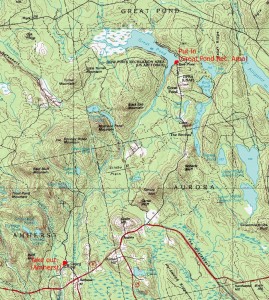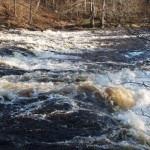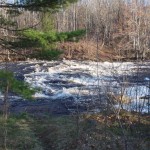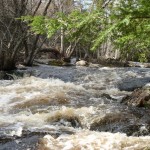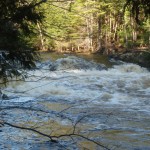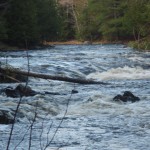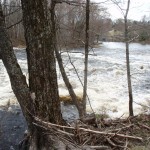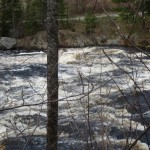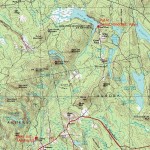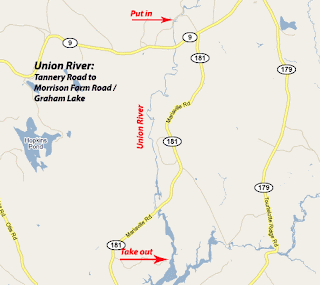Many people have put in at the boat landing on Swan Lake Avenue and paddled Upper Mason Pond. Some have followed the winding course of Goose River south from Swan Lake. Others have kayaked to the dam on Goose River at the place where it spills into Belfast Harbor, looked upstream, and wondered. We had done all these things. Many times. A curiosity about connecting the dots, an ethic of “paddle lots, drive little,” and a penchant to spend the good part of the day on the water were all part of our decision-making. A November day of sunshine and temperatures in the fifties sealed the deal.
Could we paddle Goose River from Swan Lake to the sea? The question was there. The idea of a backyard-style expedition was born.
It was a somewhat outlandish proposition. After eight miles of mind-numbing meandering, we would face five dams in the space of the last two miles, and a portage around each. We had never heard of anyone running the lower section and had never scouted it from its banks. Why would anyone attempt to run it, we conjectured, unless it was part of a bigger trip. The idea seemed just crazy enough to give it a try.
After planting a car at the far end, within sight of the ocean, we put in just below the dam at the south end of Swan Lake and paddled 50 yards north through the culvert to get as close as we could to the lake. Then we turned south toward the sun and the sea and headed south.
Ahead of us, though we didn’t fully appreciate it yet, were ten or more miles of river. Roads cross or touch the river only a half dozen times in those ten miles. For the vast majority of the distance, Goose River is hidden away in a private valley, visible only to those moving along it. Along the way, we would sight muskrat, eagle, ducks, and heron. And for the first eight miles, at least, not any people.
The ten miles of river have three distinct personalities. From Swan Lake to Smith Pond, the river is shallow, muddy, and rife with beaver activity. It winds through alder thickets and has a closed in feeling. South of Smith Pond to Upper Mason Pond, the river deepens and and weaves through a broad grassland. It becomes a home for geese, duck and muskrats. The forest shrinks back, and the sky opens up, The next stretch, from Upper Mason Pond to the sea alternates between flat reservoir and pitched stream, with each of the reservoirs being held back by a dam.
As we had anticipated, the water level upper section of Goose River was low, and the flow was minimal. This section of the river is best paddled in the spring or early summer — or after a period of heavy rainfall. The river here meanders without much sense of direction. We pushed over a beaver dam that held back about three feet of water. Below that, the river depth was shallower still. We paddled hard to keep some momentum through the many turns, well aware of the miles still ahead.
The deeper water of Smith Pond was a welcome relief. We shared an energy bar there and pushed on.
The river meanders interminably between Smith Pond and the Smart Road — and even more so after that. We had paddled this section many times and in many seasons. On this day, the bright sunshine and the subtle hues of the grasses and distant hillsides created a quiet kind of beauty.
By the time we reached Upper Mason Pond, the sun was moving with purpose toward the horizon. It hastened our purpose as well. We portaged the first dam, got back in our kayaks, and paddled the narrow channel that opens into Lower Mason Pond, which was still lit with golden sunlight.
We had hoped to eat a late lunch there along a sunny shoreline, but daylight was becoming a scarce commodity. We paddled on through the pond, portaged the dam, and then bumped down the shallow stream to where it crosses Swan Lake Avenue near Goose River Grocery.
Two dams and two quick portages later put us again in the flat water of the reservoir above dam #6.
By this time, long shadows had crept over the water, though the sun still brilliant lit the the red and orange-leafed trees above us. We took out at dam #6 and portaged around it, and then along a wide, rock-filled stream — only to find that stream levels there were too low for paddling.
After walking down along the stream a few hundred yards to confirm that it wasn’t getting any deeper, we left the kayaks in the woods, bushwacked up to the road, and continued our southward journey on foot. By then that the sun had set, and a chill filled the darkening air. I jogged the last half mile in an attempt to warm up. The car was parked down near the bay, and it was dark by the time I reached it.
Dry clothes, heated seats, and lunch were a welcome find and helped ease the disappointment of not being able to finish the journey by water. But our path on and along the river had taken us places we had not been before. Success is never guaranteed; adventures are only adventures because you don’t know the outcome. And now we get to return and try again, to run the lower part of the river — maybe after a big November rain, or maybe in the spring.

